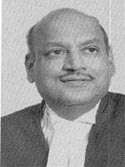Gopal Ballav Pattanaik
Gopal Ballav Pattanaik was the 32nd [3] Chief Justice of India.[4] [5]
Gopal Ballav Pattanaik | |
|---|---|
 | |
| 32nd Chief Justice of India | |
| In office 8 November 2002[1] – 18 December 2002 | |
| Appointed by | A. P. J. Abdul Kalam |
| Preceded by | Bhupinder Nath Kirpal |
| Succeeded by | V. N. Khare[2] |
| Personal details | |
| Born | 19 December 1937 Cuttack |
| Nationality | Indian |
| Spouse(s) | Meera Patnaik |
| Children | Amar, Rinku, Anjan (Grandchildren: Aaryaman, Ayushman, Devansh) |
| Alma mater | Ewing Christian College,Allahabad University Ravenshaw College Madhusudan Law College |
He was born on 19 December 1937 in the city of Cuttack, now in Odisha, India. He is the eldest son of Rashbehari Pattnaik and Bidulata Dei.
He studied at the Ravenshaw College in Cuttack and graduated in Science from the Ewing Christian College,Allahabad University and earned his degree in Law from Madhusudan Law College, Utkal University in Odisha.
In 1962, he enrolled as an advocate in the Orissa High Court, where he practiced in civil, criminal, constitutional and corporate cases. He also appeared before the Supreme Court of India.His legal career started in the chambers of late lawyer Bimal Pal and Barrister Birendra Mohan Patnaik. Justice Souri Prasad Mahapatra was instrumental in encouraging him to take up the legal profession.[6]
In 1971, he was appointed to the Standing Counsel for the state Government of Orissa. In 1974 he became an Additional Government Advocate and subsequently the Govt Advocate of the state. In 1983, he was elevated to the bench of the Orissa High Court as a permanent judge.[7] In 1995, he was appointed the Chief Justice of Patna High Court. Only four months later, he was appointed as a Judge of the Supreme Court of India. He went on to occupy the highest judicial post in the country as the 32nd Chief Justice of India on 8 November 2002.[8]
When Justice Patnaik took over as the Chief Justice of India, it appeared that he would not be able to achieve much in the administration of the judiciary, in view of his short tenure .Yet, he began a momentous chapter in the history of Indian judiciary by putting into practice the 'in-house procedure' evolved in 1997 to deal with allegations of misconduct against members of the higher judiciary.
Some of the far reaching and well published judgements of Justice Patnaik include:-
- the Narmada Dam Project.
- Denying the central government of India the ability to grant permission to Hindu organisations to perform ceremonies at the disputed Babri masjid site in Ayodhya.
- Contempt of court case against Booker Prize winner Arundhati Roy.
- Acquittal of several persons belonging to the minority community in cases relating to the Bombay riots.
- The constitutional reference on the minority educational institutions.
- In a landmark judgement in the Daniel Latifi v. Union of India, 2001 (7) SCC 740, heading the Constitutional Bench of the Supreme Court in this case, Justice Patnaik held that liability of Muslim husband to his divorced wife arising under Section 3(1) (a) of the Act to pay maintenance is not confined to iddat period. This judgement was a landmark one uplifting the rights of Muslim women in India to maintenance from their divorced husband
Read more at: http://www.livelaw.in/womens-day-special-15-judgments-that-made-india-a-better-place-for-women/
Justice Pattanaik was a member of the Indo British and Indo-U.S. judicial exchange programme. He visited UK and the United States and participated in joint workshops and seminars with the judges of the House of Lords in Britain and the U.S Supreme Court, respectively.
He was conferred with an honorary doctorate in law LLD by the Utkal University.
Justice Pattnaik is a former Chairperson of the National Judicial Academy of India, Executive Chairman of the National Legal Services Authority of India ( NALSA) and Former President of the Association of Retired Judges of Supreme Court and High Courts of India.
He now resides in New Delhi with his wife Meera and is active as an arbitrator in India and overseas. He has 3 children Amar, Anjan, and Rinku. He has 3 Grandchildren: Aaryaman Patnaik, Ayushman Patnaik and Devansh Patnaik.
External links: https://www.ommcomnews.com/odisha-news/world-human-rights-day-naveen-reiterates-inclusion-of-non-violence-in-preamble-
References
- A. P. Bhardwaj (2016). Legal Awareness and Legal Reasoning For the CLAT and LL.B. Entrance Examinations. Pearson India. pp. 1–. ISBN 978-93-325-7559-2.
- Ganesh Kumar (September 2010). Modern General Knowledge. Upkar Prakashan. pp. 142–. ISBN 978-81-7482-180-5.
- S. C. Bhatt (2005). Land and People of Indian States and Union Territories: In 36 Volumes. India. Gyan Publishing House. pp. 465–. ISBN 978-81-7835-393-7.
- "Justice Pattanaik sworn-in as new CJI". Express India. 8 November 2002. Retrieved 4 July 2012.
- https://www.thehindu.com/thehindu/2002/11/09/stories/2002110903541300.html
- http://timesofindia.indiatimes.com/india/G-B-Pattanaik-takes-oath-as-Chief-Justice-of-India/articleshow/27669480.cms
- "Archived copy". Archived from the original on 14 November 2016. Retrieved 29 August 2017.CS1 maint: archived copy as title (link)
- http://www.thehindu.com/2002/11/09/stories/2002110906130100.htm
External links
- https://www.thehindu.com/thehindu/2002/11/09/stories/2002110903541300.htm
- www.frontlineonnet.com
- supremecourtofindia.nic.in
- ibnlive.in
- orissa.gov.in
- http://orissadiary.com/Shownews.asp?id=18357
| Legal offices | ||
|---|---|---|
| Preceded by Bhupinder Nath Kirpal |
Chief Justice of India 8 Nov 2002 – 18 Dec 2002 |
Succeeded by V. N. Khare |